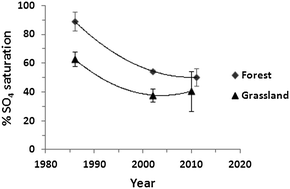Recovery of sulfate saturated soils in the Plynlimon catchments, mid-Wales following reductions in atmospheric S inputs from the 1980s to 2011
Abstract

Maintenance work is planned for Wednesday 1st May 2024 from 9:00am to 11:00am (BST).
During this time, the performance of our website may be affected - searches may run slowly and some pages may be temporarily unavailable. If this happens, please try refreshing your web browser or try waiting two to three minutes before trying again.
We apologise for any inconvenience this might cause and thank you for your patience.
* Corresponding authors
a
Centre for Ecology and Hydrology, Environment Centre Wales, Deiniol Road, Bangor, Gwynedd LL57 2UW, United Kingdom
E-mail:
shug@ceh.ac.uk, br@ceh.ac.uk, danor@ceh.ac.uk, sabr@ceh.ac.uk
Fax: +44 (0) 1248 362133
Tel: +44 (0) 1248 374500
b
Department of Geosciences, Pennsylvania State University, University Park, Pennsylvania PA16802, USA
E-mail:
ald271@psu.edu
Fax: +01 814 863 8094
Tel: +01 858 243 2644
c
Centre for Ecology and Hydrology, Lancaster Environment Centre, Library Avenue, Bailrigg, Lancaster LA1 4AP, United Kingdom
E-mail:
cw@ceh.ac.uk
Fax: +44 (0) 1524 61536
Tel: +44 (0) 1524 595800
d
Centre for Ecology and Hydrology, Maclean Building, Benson Lane, Crowmarsh Gifford, Wallingford, Oxfordshire OX10 8BB, United Kingdom
E-mail:
lkh@ceh.ac.uk, saha@ceh.ac.uk, hdw@ceh.ac.uk
Fax: +44 (0) 1491 692424
Tel: +44 (0) 1491 838800

 Please wait while we load your content...
Something went wrong. Try again?
Please wait while we load your content...
Something went wrong. Try again?
S. Hughes, B. Reynolds, D. A. Norris, S. A. Brittain, A. L. Dere, C. Woods, L. K. Armstrong, S. A. Harman and H. D. Wickham, J. Environ. Monit., 2012, 14, 1531 DOI: 10.1039/C2EM30070B
To request permission to reproduce material from this article, please go to the Copyright Clearance Center request page.
If you are an author contributing to an RSC publication, you do not need to request permission provided correct acknowledgement is given.
If you are the author of this article, you do not need to request permission to reproduce figures and diagrams provided correct acknowledgement is given. If you want to reproduce the whole article in a third-party publication (excluding your thesis/dissertation for which permission is not required) please go to the Copyright Clearance Center request page.
Read more about how to correctly acknowledge RSC content.
 Fetching data from CrossRef.
Fetching data from CrossRef.
This may take some time to load.
Loading related content
